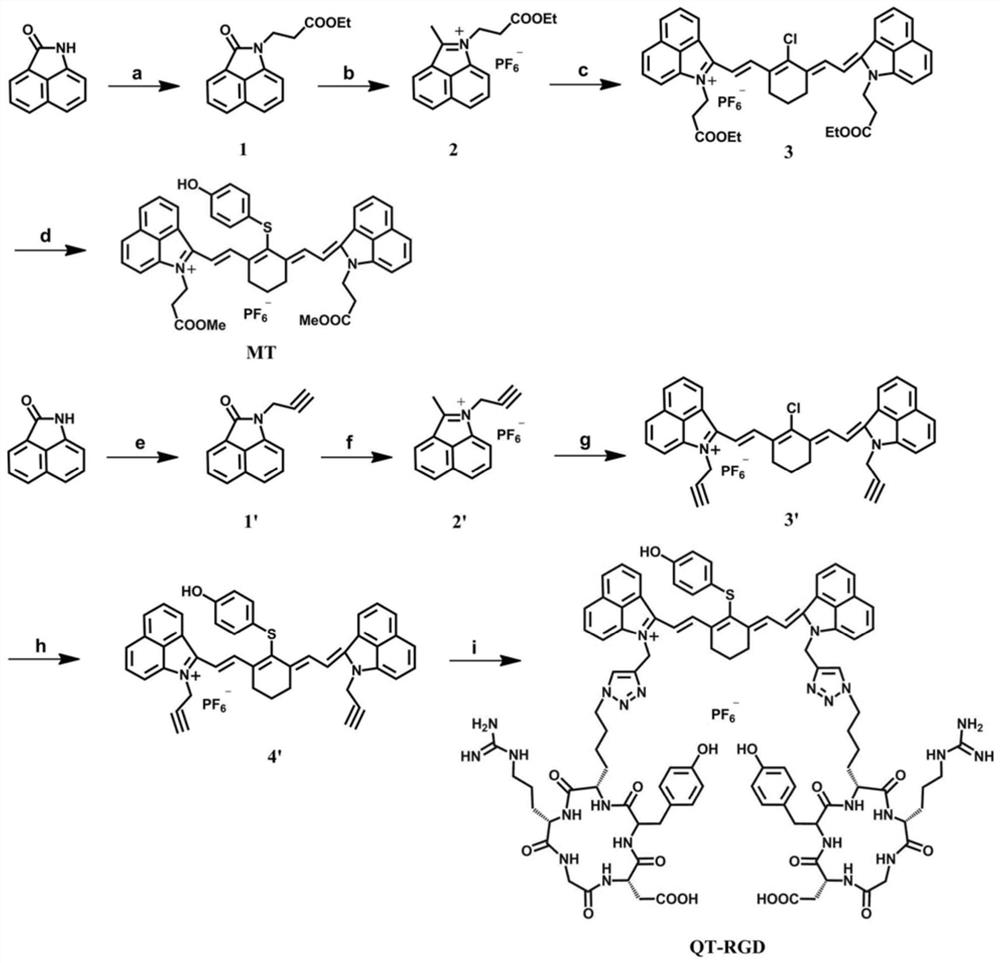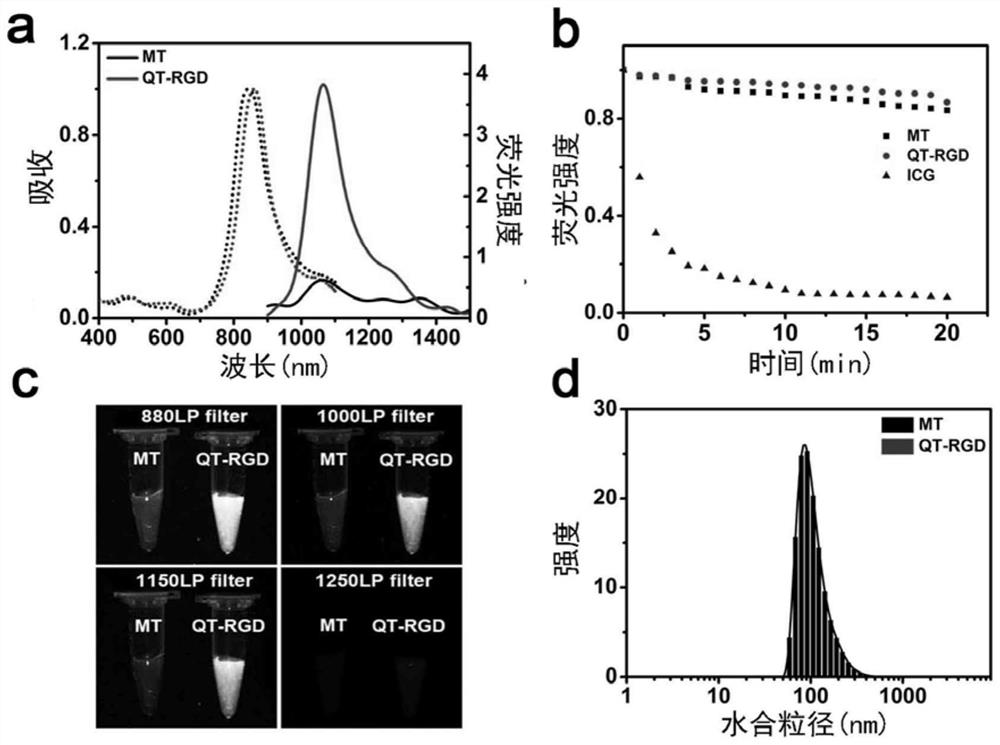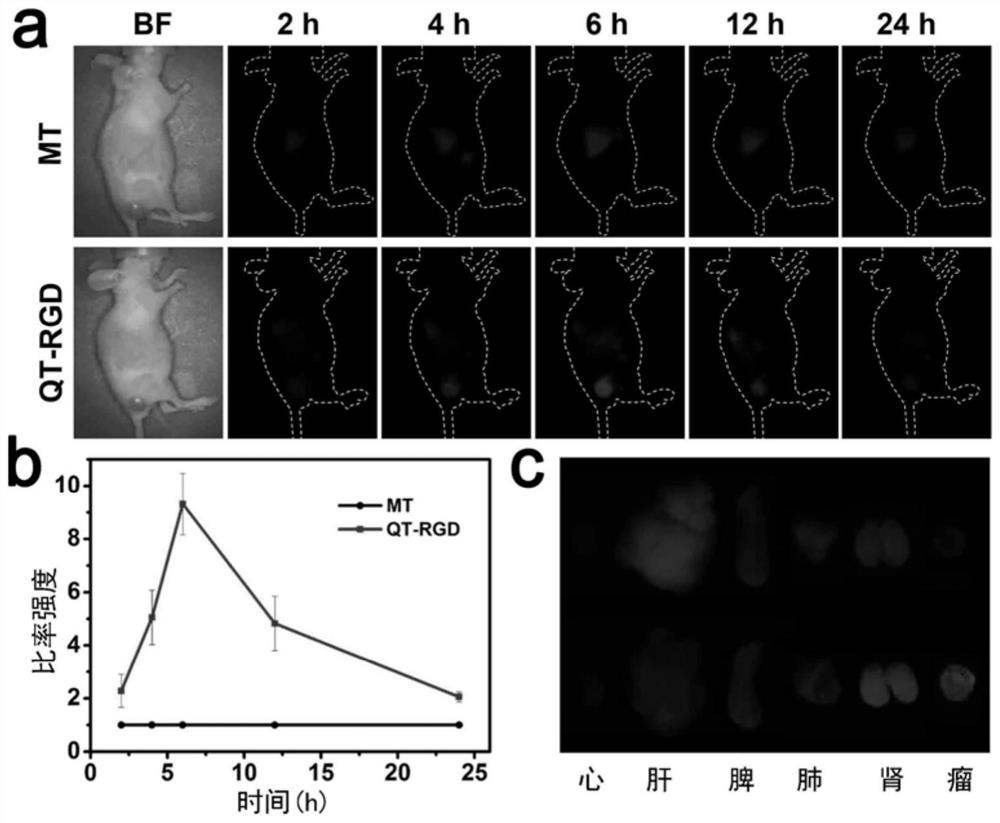High stability near-infrared second region small molecule fluorescent probe and its preparation method and application
A high-stability, fluorescent probe technology, used in fluorescence/phosphorescence, chemical instruments and methods, luminescent materials, etc., can solve the problems of poor stability and weak integration of diagnosis and treatment, and achieve significant effects and good active targeting. Effect
- Summary
- Abstract
- Description
- Claims
- Application Information
AI Technical Summary
Problems solved by technology
Method used
Image
Examples
Embodiment 1
[0065] Example 1: Synthesis of a novel high-stability near-infrared second-region small-molecule fluorescent probe QT-RGD and a control probe MT
[0066] (1) Under nitrogen protection, add naphthalimide (2.53 g, 15.0 mmol), methyl 3-bromopropionate (8.15 g, 45.0 mmol) and 50 mL of anhydrous N, N -Dimethylformamide was used as a solvent, and the mixture was magnetically stirred and refluxed for 6 h. The reaction was completed, cooled to room temperature, the mixture was poured into 500 mL of ice-water mixture, and the pH was adjusted to neutral with 1 mol / L hydrochloric acid aqueous solution, filtered under reduced pressure, and the crude product was purified by silica gel column chromatography (petroleum ether: ethyl acetate Esters = 9:1, v / v), the product was yellow solid compound 1 (3.14 g, yield: 78 %). Maldi-Tof: m / z , cal : 256.10, found : 256.08 [M + ].
[0067] (2) Under nitrogen-protected ice-bath conditions, add compound 1 (1.35 g, 5.0 mmol) and 40 mL of anhy...
Embodiment 2
[0077] Example 2: Photophysical properties of a novel high-stability near-infrared second-region small-molecule fluorescent probe
[0078] Dilute the probe QT-RGD of the experimental group and the probe MT of the control group prepared in Example 1 to a concentration of 5 μM with ultrapure water, and measure their UV-visible-near-infrared spectrophotometer and fluorescence spectrophotometer. Infrared spectroscopy and fluorescence spectroscopy. Such as figure 2 As shown in (a), the results show that the best absorption of the probe QT-RGD is at 855 nm, while the best absorption of the probe MT of the control group is slightly blue-shifted to 840 nm; the fluorescence spectra in the second near-infrared region have obvious differences , the probe QT-RGD of the experimental group showed a strong emission fluorescence signal in the second near-infrared region in aqueous solution, while the probe MT of the control group had no significant fluorescence emission.
[0079] Dilute th...
Embodiment 3
[0082] Example 3: In vivo near-infrared second-region fluorescence imaging of a novel high-stability near-infrared second-region small molecule fluorescent probe
[0083] The probe QT-RGD of the experimental group and the probe MT of the control group prepared in Example 1 were dissolved in PBS solution (concentration: 100 μM, volume: 200 μL), and the probes were injected into the tail vein respectively. BALB / c / Nu female nude mice bearing tumors (4T1 mouse breast cancer) were placed in the small animal Serious II 900-1700 nm near-infrared second region in vivo imaging system (excitation wavelength: 808 nm) for real-time observation and imaging Finally, the in vivo imaging analysis software was used to calculate the fluorescence intensity of the tumor site in nude mice at different time points. In vivo fluorescence imaging of the probe QT-RGD in the experimental group and the probe MT in the control group at different time points: image 3 As shown in (a), the results show tha...
PUM
 Login to View More
Login to View More Abstract
Description
Claims
Application Information
 Login to View More
Login to View More - R&D
- Intellectual Property
- Life Sciences
- Materials
- Tech Scout
- Unparalleled Data Quality
- Higher Quality Content
- 60% Fewer Hallucinations
Browse by: Latest US Patents, China's latest patents, Technical Efficacy Thesaurus, Application Domain, Technology Topic, Popular Technical Reports.
© 2025 PatSnap. All rights reserved.Legal|Privacy policy|Modern Slavery Act Transparency Statement|Sitemap|About US| Contact US: help@patsnap.com



